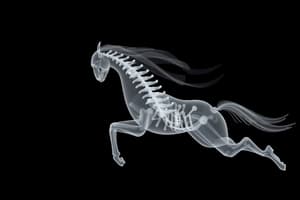Podcast
Questions and Answers
What type of motion is characterized by repeated back-and-forth movement?
What type of motion is characterized by repeated back-and-forth movement?
- Rotational Motion
- Periodic Motion
- Translational Motion
- Oscillatory Motion (correct)
Which quantity refers to the object's change in position and is a vector quantity?
Which quantity refers to the object's change in position and is a vector quantity?
- Speed
- Displacement (correct)
- Distance
- Velocity
Which law states that an object in motion stays in motion unless acted upon by an external force?
Which law states that an object in motion stays in motion unless acted upon by an external force?
- Newton's Third Law
- Newton's Fourth Law
- Newton's Second Law
- Newton's First Law (correct)
What is the formula for calculating speed?
What is the formula for calculating speed?
Which type of motion repeats at regular intervals, and can be either oscillatory or circular?
Which type of motion repeats at regular intervals, and can be either oscillatory or circular?
Which of the following correctly describes the relationship defined by Newton's Second Law?
Which of the following correctly describes the relationship defined by Newton's Second Law?
What principle states that the total momentum in a closed system remains constant before and after an event?
What principle states that the total momentum in a closed system remains constant before and after an event?
Which of the following is an example of rotational motion?
Which of the following is an example of rotational motion?
Flashcards are hidden until you start studying
Study Notes
Definition of Motion
- Motion refers to the change in position of an object with respect to time.
- It is relative; an object is in motion only when compared to another object.
Types of Motion
-
Translational Motion
- Movement along a path from one location to another.
- Can be straight (linear) or curved.
-
Rotational Motion
- Movement around an axis.
- Examples include spinning wheels or the Earth rotating on its axis.
-
Oscillatory Motion
- Repeated back-and-forth movement.
- Examples include pendulums and springs.
-
Periodic Motion
- Motion that repeats at regular intervals.
- Can be both oscillatory and circular (e.g., seasons, tides).
Key Concepts
-
Displacement: Vector quantity that refers to the object's change in position.
-
Distance: Scalar quantity representing the total path length traveled by an object.
-
Speed: Scalar measure of how fast an object is moving. Calculated as:
- Speed = Distance / Time
-
Velocity: Vector quantity that includes direction. Calculated as:
- Velocity = Displacement / Time
-
Acceleration: Rate of change of velocity; can be positive (speeding up) or negative (slowing down).
Laws of Motion
-
Newton's First Law (Inertia):
- An object at rest stays at rest, and an object in motion stays in motion unless acted upon by a net external force.
-
Newton's Second Law (F=ma):
- The force acting on an object equals the mass of the object multiplied by its acceleration.
-
Newton's Third Law (Action-Reaction):
- For every action, there is an equal and opposite reaction.
Frames of Reference
- An observer’s frame of reference affects the perception of motion.
- Common frames include stationary and moving reference points.
Laws of Conservation
- Conservation of Momentum: In a closed system, the total momentum before and after an event remains constant.
- Conservation of Energy: Energy cannot be created or destroyed, only transformed from one form to another during motion.
Examples of Motion in Real Life
- Vehicles moving on a road (translational).
- Earth rotating on its axis (rotational).
- Pendulums in clocks (oscillatory).
Applications
- Motion is fundamental in physics, engineering, and various applied sciences, influencing vehicle design, aerospace technology, and robotics.
Motion: Change in Position Over Time
- Motion describes an object's change in position over time relative to another reference point.
Types of Motion
- Translational Motion: Movement along a path, either straight (linear) or curved.
- Rotational Motion: Movement around an axis, like a spinning wheel.
- Oscillatory Motion: Repeated back-and-forth movements, seen in pendulums and springs.
- Periodic Motion: Motion that repeats at regular intervals, including oscillatory and circular motion.
Key Concepts
- Displacement: The change in an object's position, a vector quantity, meaning it has both magnitude and direction.
- Distance: The total path length traveled by an object, a scalar quantity, with only magnitude.
- Speed: How fast an object is moving, measured as distance over time, a scalar quantity.
- Velocity: The rate of change of displacement, a vector quantity, taking direction into account.
- Acceleration: The rate of change of velocity, positive for speeding up, negative for slowing down.
Laws of Motion
- Newton's First Law (Inertia): An object at rest stays at rest, and an object in motion stays in motion with the same speed and direction unless acted upon by an unbalanced force.
- Newton's Second Law (F=ma): The force acting on an object is directly proportional to its mass and acceleration.
- Newton's Third Law (Action-Reaction): For every action, there is an equal and opposite reaction.
Frames of Reference
- An observer's perspective (frame of reference) affects how they perceive motion. It can be stationary or moving.
Conservation Laws
- Conservation of Momentum: In a closed system, the total momentum (mass in motion) before and after an event remains constant.
- Conservation of Energy: Energy cannot be created or destroyed, only transformed from one form to another during motion.
Real-Life Examples
- Vehicles moving on a road exhibit translational motion.
- The Earth rotating on its axis demonstrates rotational motion.
- Pendulums in clocks display oscillatory motion.
Applications
- Motion is fundamental to physics, engineering, and other applied sciences, influencing everything from vehicle design and aerospace technology to robotics.
Studying That Suits You
Use AI to generate personalized quizzes and flashcards to suit your learning preferences.




